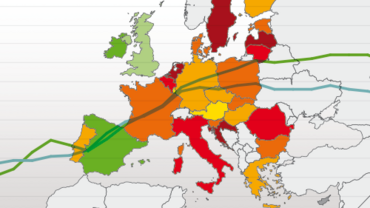European Antimicrobial Resistance Surveillance Network (EARS-Net)
The European Antimicrobial Resistance Surveillance Network (EARS-Net) is the largest publicly funded system for antimicrobial resistance (AMR) surveillance in Europe. Data from EARS-Net play an important role in raising awareness at the political level, among public health officials, in the scientific community, and among the general public. Public access to descriptive data (maps, graphs and tables) are available through the ECDC Surveillance Atlas of Infectious Diseases; more detailed analyses are presented in annual reports and scientific publications.
The objectives of EARS-Net are to:
- collect comparable, representative and accurate AMR data;
- analyse temporal and spatial trends of AMR in Europe;
- provide timely AMR data for policy decisions;
- encourage the implementation, maintenance and improvement of national AMR surveillance programmes; and
- support national systems in their efforts to improve diagnostic accuracy by offering annual external quality assessments (EQA).
Organisation
- List of national organisations participating in EARS-Net: The latest information on the national institutions and organisations participating in EARS-Net can be found in an annex to the EARS-Net Annual Report.
- EARS-Net management and coordination: EARS-Net is managed and coordinated by ECDC, supported by a coordination committee composed of experts selected from the appointed disease-specific contact points.
Institutions and organisations participating in EARS-Net
|
Country |
Participating institutions |
|
Austria |
|
|
Belgium |
|
|
Bulgaria |
|
|
Croatia |
|
|
Ministry of Health Zagreb University Hospital for Infectious Diseases "Dr Fran Mihaljević" |
|
|
Cyprus |
|
|
Czechia |
|
|
Denmark |
|
|
Danish Study Group for Antimicrobial Resistance Surveillance (DANRES) |
|
|
Estonia |
|
|
Finland |
Finnish Institute for Health and Welfare, Department of Health Security |
|
France |
|
|
Since 2020: |
|
|
Surveillance and Prevention of Antimicrobial RESistance in hospital settings (SPARES) |
|
|
Up to 2019: |
|
|
French National Observatory for the Epidemiology of Bacterial Resistance to Antimicrobials (ONERBA) through three participating networks: |
|
|
Azay-Résistance |
|
|
Île-de-France |
|
|
Réussir |
|
|
Germany |
|
|
Greece |
National Public Health Organization, Central Public Health Laboratory |
|
University of West Attica, Department of Public Health Policy, School of Public Health |
|
|
Hungary |
|
|
Iceland |
|
|
Ireland |
|
|
Italy |
|
|
Latvia |
|
|
Liechtenstein |
– |
|
Lithuania |
|
|
Luxembourg |
|
|
Malta |
Malta Mater Dei Hospital, Msida |
|
Netherlands |
|
|
Norway |
University Hospital of North Norway |
|
Norwegian Institute of Public Health |
|
|
St Olav University Hospital, Trondheim |
|
|
Poland |
National Medicines Institute, Department of Epidemiology and Clinical Microbiology |
|
Portugal |
|
|
Ministry of Health Directorate-General of Health |
|
|
Directorate-General of Health |
|
|
Romania |
National Institute of Public Health |
|
Slovakia |
National Reference Centre for Antimicrobial Resistance |
|
Regional Public Health Authority Banska Bystrica |
|
|
Slovenia |
|
|
Spain |
|
|
National Centre for Microbiology |
|
|
Sweden |
History
The European Antimicrobial Resistance Surveillance System (EARSS), established in 1998, is the predecessor of EARS-Net. EARSS was initially funded by the European Commission’s Directorate General for Health and Consumer Affairs and the Dutch Ministry of Health, Welfare and Sports. The network steadily grew and involved an increasing number of European countries. On 1 January 2010, the administration and coordination of EARSS was transferred to the European Centre for Disease Prevention and Control (ECDC). The network was renamed to ‘European Antimicrobial Resistance Surveillance Network (EARS-Net)’.
Data collection and analysis
How are the data collected and processed?
EARS-Net is based on routine clinical antimicrobial susceptibility data from local and clinical laboratories reported to ECDC by appointed representatives from the Member States. The data originate form national AMR surveillance initiatives and/or laboratory networks. Only data from invasive isolates (blood and cerebrospinal fluid) are included in EARS-Net.
What surveillance data are collected?
EARS-Net performs surveillance of antimicrobial susceptibility of eight bacterial pathogens commonly causing infections in humans:
- Escherichia coli
- Klebsiella pneumoniae
- Pseudomonas aeruginosa
- Acinetobacter species
- Streptococcus pneumoniae
- Staphylococcus aureus
- Enterococcus faecalis
- Enterococcus faecium
The EARS-Net reporting protocol defines the panels of antimicrobial agent combinations under surveillance for each species. In addition, the EUCAST guidelines for the detection of resistance mechanisms and specific types of resistance of clinical and/or epidemiological importance explain the mechanisms of resistance and describe the recommended methods of detection for key species–antimicrobial group combinations. For further details on EARS-Net data collection and analysis, please refer to the latest EARS-Net reporting protocol.
Publication of results
- The ECDC Surveillance Atlas of Infectious Diseases provides user-friendly access to data in various downloadable formats, such as tables, figures, and maps. Select ‘Antimicrobial resistance’ in the drop-down menu.
- Also available are various annual reports and related publications on current and historical trends in the occurrence of antimicrobial resistance across Europe.
Interpretation of results
Surveillance data on antimicrobial resistance should be interpreted with caution, especially regarding inter-country comparisons, but also national trends. A number of factors can influence data quality and introduce bias to the data, resulting in over- as well as underestimation of resistance percentages. Some of the most important potential sources of bias in EARS-Net are explained below.
Population coverage
Population coverage varies among reporting countries. Some countries report data from large national surveillance systems with a high national coverage, while other countries report data from a smaller subset of local laboratories and hospitals.
For countries reporting data from only a small number of hospitals and laboratories located in one specific geographical area, the sample may not be representative for the whole country. Likewise, national trends may not be representative of regional situations as pooled data could mask variations at the local level.
For some countries, the population under surveillance is not constant and may change over the years due to variations in the number of participating laboratories. To control for this potential bias in trend analyses, an additional sensitivity analysis including a subset of data originating only from laboratories reporting for all the previous four years is provided for all national trend analyses.
Sampling
EARS-Net data are exclusively based on invasive isolates from blood or cerebrospinal fluid. The clinical relevance of indicator organisms isolated from these sites is undisputable. This restriction prevents some of the inconsistencies that arise from differences in clinical case definitions, different sampling frames or heterogeneous healthcare utilisation that would otherwise confound the data analysis if isolates from all anatomical sites were accepted. However, invasive isolates may not be representative of isolates of the same bacterial species from other type of infections, i.e. urinary tract infections, pneumonia, wound infections, etc.
Case ascertainment of patients with bloodstream infections (BSIs) is strongly linked to diagnostic practices and the frequency with which blood cultures are taken. Therefore, variations in blood culture frequency (non-differential sampling) result in an increasing uncertainty when comparing resistance percentages between hospitals and countries. Extrapolations of EARS-Net data as a measure of BSI incidence could therefore underestimate the true value in countries with low blood culture frequency.
Differential sampling can occur if blood cultures are only performed after empirical treatment shows no adequate therapeutic response. Predictably, this will lead to an overestimation of the resistance percentage by not including susceptible BSI isolates from the denominator.
Laboratory routines and capacity
The use of guidelines for clinical breakpoints varies among countries in Europe, and in some instances even between laboratories in the same country. At present, many European laboratories are changing from using Clinical and Laboratory Standards Institute (CLSI) to EUCAST clinical guidelines. As a result, the interpretation of AST results may vary, at least for resistance mechanisms resulting in minimum inhibitory concentrations (MICs) close to the breakpoints. In addition, clinical breakpoints may change over time, as breakpoints may be revised. As quantitative data (i.e. disk diffusion zone diameters or MIC values) are not provided by all participating laboratories, only the reported S, I, and R results are considered for the analyses.
The ability to identify the microorganism and its associated antimicrobial susceptibility pattern may differ among laboratories. All laboratories providing data for EARS-Net are offered participation in an annual external quality assessment (EQA) to assess the reliability of the laboratory test results.
For more information on the EARS-Net EQA and laboratory performance, are available in the EARS-Net Annual Reports below.






